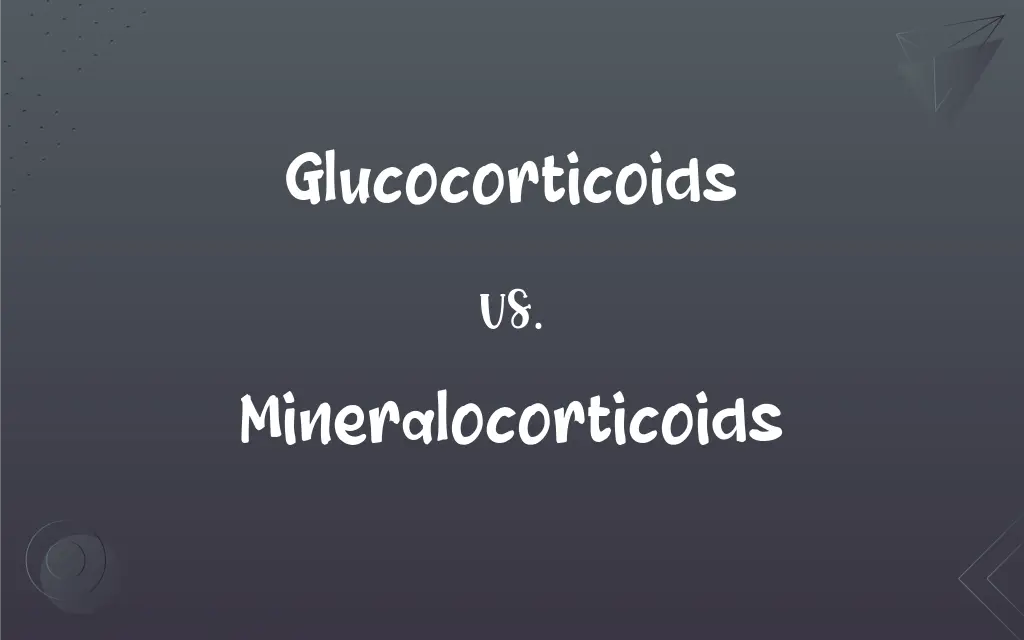Glucocorticoids vs. Mineralocorticoids: What's the Difference?
Edited by Aimie Carlson || By Harlon Moss || Updated on October 6, 2023
Glucocorticoids regulate metabolism and immune response, while mineralocorticoids control electrolyte and water balance.

Key Differences
Glucocorticoids and mineralocorticoids are two classes of steroid hormones produced by the adrenal cortex. While they both play pivotal roles in maintaining homeostasis within the body, their primary functions differ significantly. Glucocorticoids, such as cortisol, play a crucial role in the regulation of glucose metabolism, modulation of stress responses, and the suppression of inflammatory reactions. Mineralocorticoids, on the other hand, mainly focus on maintaining electrolyte balance and overall fluid homeostasis.
A primary function of glucocorticoids is to increase blood glucose levels during periods of stress. When the body perceives a stressor, the hypothalamus releases corticotropin-releasing hormone (CRH), leading to an eventual release of glucocorticoids. These hormones act on various tissues to mobilize glucose. Conversely, mineralocorticoids like aldosterone work predominantly on the kidney's renal tubules, promoting sodium retention and potassium excretion, crucial for maintaining blood pressure and fluid balance.
Additionally, glucocorticoids play a pivotal role in the immune system. They exhibit anti-inflammatory properties and are often used therapeutically in conditions like asthma, rheumatoid arthritis, or inflammatory bowel disease. Mineralocorticoids don't have a significant direct role in immunity. Instead, their primary concern is the maintenance of blood volume and electrolytic balance, ensuring organs receive adequate perfusion.
While both glucocorticoids and mineralocorticoids have essential functions, their regulatory pathways are distinct. The release of glucocorticoids is majorly controlled by the hypothalamic-pituitary-adrenal (HPA) axis. In contrast, mineralocorticoids are mainly regulated by the renin-angiotensin-aldosterone system, responding to changes in blood volume and potassium levels.
Comparison Chart
Primary Function
Regulate metabolism & immune response
Control electrolyte & water balance
ADVERTISEMENT
Main Hormone
Cortisol
Aldosterone
Effect on Immunity
Anti-inflammatory
Minimal direct role
Regulation
Hypothalamic-pituitary-adrenal (HPA) axis
Renin-angiotensin-aldosterone system
Target Organs
Various tissues (e.g., liver, muscle)
Primarily kidneys
Glucocorticoids and Mineralocorticoids Definitions
Glucocorticoids
Immune system modulators with anti-inflammatory effects.
Glucocorticoids are used to treat inflammatory conditions.
ADVERTISEMENT
Mineralocorticoids
Steroid hormones controlling electrolyte balance.
Mineralocorticoids prevent dehydration by retaining sodium.
Glucocorticoids
Hormones produced by the adrenal cortex.
The adrenal gland releases glucocorticoids in response to stress.
Mineralocorticoids
Essential for maintaining blood volume and pressure.
Without mineralocorticoids, blood pressure might drop.
Glucocorticoids
Steroid hormones regulating glucose metabolism.
Glucocorticoids help maintain blood sugar during fasting.
Mineralocorticoids
Chiefly represented by aldosterone.
Aldosterone is the primary mineralocorticoid in the body.
Glucocorticoids
Regulated by the hypothalamic-pituitary-adrenal axis.
CRH from the hypothalamus stimulates glucocorticoid secretion.
Mineralocorticoids
Regulated by the renin-angiotensin-aldosterone system.
Low blood volume triggers mineralocorticoid release.
Glucocorticoids
Key players in the body's stress response.
When stressed, the body increases glucocorticoid production.
Mineralocorticoids
Hormones mainly affecting kidney function.
Mineralocorticoids ensure proper blood filtration in kidneys.
Glucocorticoids
Any of a group of steroid hormones, such as cortisol, that are produced by the adrenal cortex, are involved in carbohydrate, protein, and fat metabolism, and have anti-inflammatory properties.
Mineralocorticoids
Any of a group of steroid hormones, such as aldosterone, that are secreted by the adrenal cortex and regulate the balance of water and electrolytes in the body.
Glucocorticoids
Plural of glucocorticoid
Mineralocorticoids
Plural of mineralocorticoid
FAQs
How do mineralocorticoids influence the kidneys?
They regulate sodium retention and potassium excretion.
Can glucocorticoids affect inflammation?
Yes, glucocorticoids have anti-inflammatory properties.
Which gland produces both hormone types?
The adrenal cortex produces both.
Which hormone exemplifies mineralocorticoids?
Aldosterone is a prime example.
How do glucocorticoids respond to stress?
They increase glucose levels to meet energy needs.
What do mineralocorticoids preserve in the body?
They maintain fluid and electrolyte balance.
What's the relationship between the HPA axis and glucocorticoids?
The HPA axis regulates the release of glucocorticoids in response to stress.
What triggers mineralocorticoid release?
Changes in blood volume and potassium levels regulate them.
Are glucocorticoids used in medical treatments?
Yes, for conditions like asthma and arthritis.
How does aldosterone affect blood pressure?
It retains sodium and water, raising blood volume and pressure.
Why are mineralocorticoids essential for athletic performance?
They help in fluid balance, ensuring optimal muscle function and preventing dehydration.
Is there a synthetic form of glucocorticoids used in medicine?
Yes, examples include prednisone and dexamethasone, often used as anti-inflammatory drugs.
What are glucocorticoids primarily responsible for?
Glucocorticoids regulate glucose metabolism and immune responses.
Which hormone is key in the body's stress response?
Cortisol, a glucocorticoid, plays this role.
Are there side effects to prolonged glucocorticoid use?
Yes, such as osteoporosis and suppressed immunity.
Can mineralocorticoids affect heart function?
Yes, by influencing blood volume and pressure, which indirectly affects heart function.
In what condition might someone receive mineralocorticoid treatment?
In conditions like Addison's disease, where there's an underproduction of adrenal hormones.
Can overproduction of glucocorticoids lead to a specific syndrome?
Yes, it can lead to Cushing's syndrome, characterized by weight gain, bruising, and other symptoms.
How do mineralocorticoids respond to high potassium levels?
They promote potassium excretion in the kidneys to normalize levels.
How do glucocorticoids affect fat distribution?
They can lead to central obesity or a "moon face" appearance with prolonged high levels.
About Author
Written by
Harlon MossHarlon is a seasoned quality moderator and accomplished content writer for Difference Wiki. An alumnus of the prestigious University of California, he earned his degree in Computer Science. Leveraging his academic background, Harlon brings a meticulous and informed perspective to his work, ensuring content accuracy and excellence.
Edited by
Aimie CarlsonAimie Carlson, holding a master's degree in English literature, is a fervent English language enthusiast. She lends her writing talents to Difference Wiki, a prominent website that specializes in comparisons, offering readers insightful analyses that both captivate and inform.































































